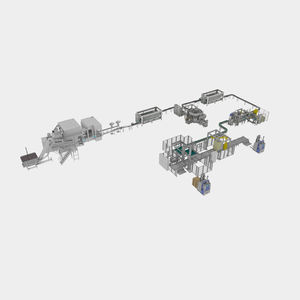
- Products
- Catalogs
- News & Trends
- Exhibitions
Aseptic packaging line for the beverage industryfor the food industryfor PET bottles
Add to favorites
Compare this product
Characteristics
- Application domain
- for the beverage industry, for the food industry
- Product applications
- for PET bottles, fruit juice, tea, for milk, liquid dairy products
- Other characteristics
- aseptic
- Throughput
Min.: 10,000 p/h
Max.: 60,000 p/h
Description
Perfectly defined liquid recipes and processing methods, combined with the right PET bottle and aseptic packaging solution, can ensure maximum product integrity along the supply chain for juices, nectars, soft drinks, isotonic and teas (JNSDIT) as well as liquid dairy products (LDP), while optimizing uptime, costs and sustainability.
We have worked with the dairy and JNSDIT industries for more than 50 and 60 years, respectively. Forty years of aseptic packaging expertise has led to our development of proven solutions, including innovative dry preform decontamination and traditional wet-bottle decontamination.
The combination of PET, the best material in terms of carbon footprint, dry preform decontamination, which cuts to zero the use of water, and aseptic technology, which does not require aluminum foils and highly pollutant refrigerated transportations, makes Sidel’s aseptic line the most sustainable packaging solution for your needs.
One partner for all your needs
A fully connected aseptic line lets you optimize performance and make more informed decisions across the lifetime of your line with regard to food safety and productivity goals. Sidel's holistic, flexible approach is dedicated to meeting all of your aseptic production needs.
Catalogs
No catalogs are available for this product.
See all of SIDEL‘s catalogsRelated Searches
- Automatic filler
- Liquid filler
- Automatic labelling machine
- Bottle filler
- Palletizer
- Bottle labeling machine
- Shrink wrapper
- Automatic shrink wrapper
- Multi-head filler
- Side labelling machine
- SIDEL packaging line
- Case packer
- Automatic case packer
- Robotic palletizer
- Compact filler
- Shrink wrapper with shrink tunnel
- Labeller for the beverage industry
- Wrap-around labelling machine
- Compact labelling machine
- Can filler
*Prices are pre-tax. They exclude delivery charges and customs duties and do not include additional charges for installation or activation options. Prices are indicative only and may vary by country, with changes to the cost of raw materials and exchange rates.









